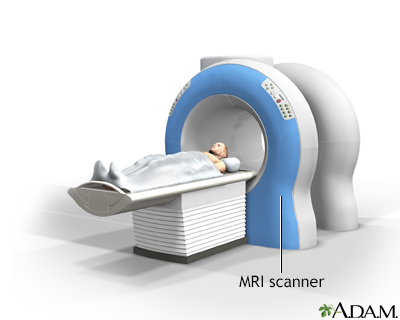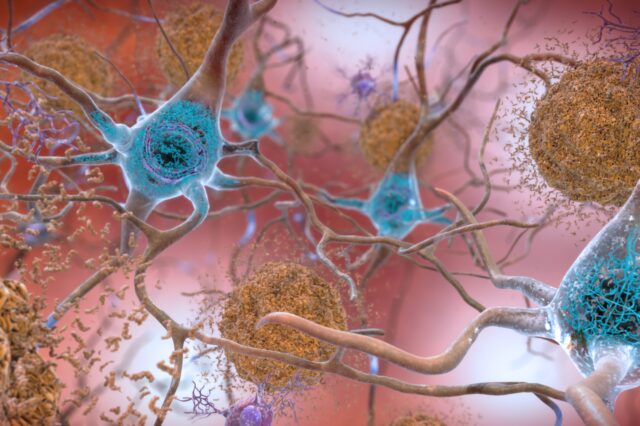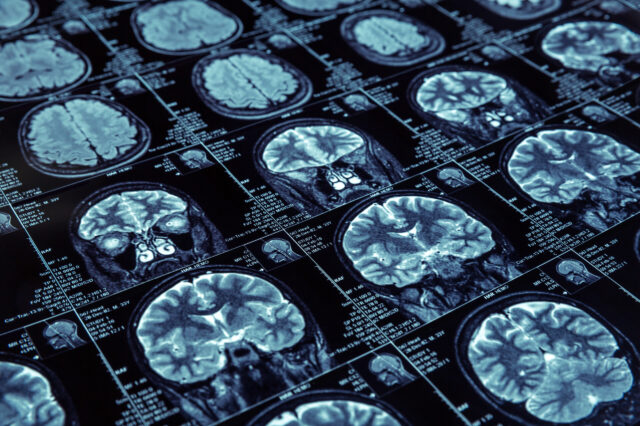- Status
- Accepting Candidates
MRI
Definition
A magnetic resonance imaging (MRI) scan is an imaging test that uses powerful magnets and radio waves to create pictures of the body. It does not use ionizing radiation (x-rays).
Single MRI images are called slices. The images can be stored on a computer or printed on film. One exam can produce thousands of images.
Different types of MRI include:
Alternative Names
Magnetic resonance imaging; Nuclear magnetic resonance (NMR) imaging
How the Test is Performed
You may be asked to wear a hospital gown or clothing without zippers or snaps (such as sweatpants and a t-shirt). Certain types of metal can cause blurry images.
You will lie on a narrow table, which slides into a large tunnel-shaped scanner.
Some exams require a special dye (contrast). Most of the time, the dye will be given through a vein (IV) in your hand or forearm before the test. The dye helps the radiologist see certain areas more clearly.
Small devices, called coils, may be placed around the head, arm, or leg, or around other areas to be studied. These help send and receive the radio waves, and improve the quality of the images.
During the MRI, the person who operates the machine will watch you from another room. The test usually lasts about 30 to 60 minutes, but may take longer.
How to Prepare for the Test
You may be asked not to eat or drink anything for 4 to 6 hours before the scan.
Tell your health care provider if you are afraid of close spaces (have claustrophobia). You may be given a medicine to help you feel sleepy and less anxious, or your provider may suggest an open MRI, in which the machine is not as close to the body.
Before the test, tell your provider if you have:
- Artificial heart valves
- Brain aneurysm clips
- Heart defibrillator or pacemaker
- Inner ear (cochlear) implants
- Kidney disease or dialysis (you may not be able to receive contrast)
- Recently placed artificial joints
- Vascular stents
- Worked with sheet metal in the past (you may need tests to check for metal pieces in your eyes)
Because the MRI contains strong magnets, metal objects are not allowed into the room with the MRI scanner:
- Items such as jewelry, watches, credit cards, and hearing aids can be damaged.
- Pens, pocketknives, and eyeglasses may fly across the room.
- Pins, hairpins, metal zippers, and similar metallic items can distort the images.
- Removable dental work should be taken out just before the scan.
How the Test will Feel
An MRI exam causes no pain. If you have difficulty lying still or are very nervous, you may be given a medicine to relax you. Too much movement can blur MRI images and cause errors.
The table may be hard or cold, but you can request a blanket or pillow. The machine produces loud thumping and humming noises when turned on. You can wear ear plugs to help reduce the noise.
An intercom in the room allows you to speak to someone at any time. Some MRI facilities have televisions and special headphones that you can use to help the time pass.
There is no recovery time, unless you were given a medicine to relax. After an MRI scan, you can resume your normal diet, activity, and medicines.
Why the Test is Performed
Having an MRI can often help:
- Diagnose an infection
- Guide a doctor to the right area during a biopsy
- Identify masses and tumors, including cancer
- Study blood vessels
MRI images taken after a special dye (contrast) is delivered into your body may provide extra information about the blood vessels.
A magnetic resonance angiogram (MRA) is a form of magnetic resonance imaging that creates 3-dimensional pictures of blood vessels.
Normal Results
A normal result means the body area being studied looks normal.
What Abnormal Results Mean
Results depend on the part of the body being examined and the nature of the problem. Different types of tissues send back different MRI signals. For example, healthy tissue sends back a slightly different signal than cancerous tissue. Consult your provider with any questions and concerns.
Risks
MRI does not use ionizing radiation. No side effects from the magnetic fields and radio waves have been reported.
The most common type of contrast (dye) used is gadolinium. This substance is thought to be generally safe for most people. Gadolinium is retained in the brain and other organs (including the skin in people with kidney disease) after use. In rare cases, organ and skin damage have occurred in patients with preexisting kidney failure. Tell your provider before the test if you have kidney problems.
The strong magnetic fields created during an MRI can cause heart pacemakers and other implants not to work as well. The magnets can also cause a piece of metal inside your body to move or shift.
Gallery

References
Carpenter JP, Litt H, Gowda M. Magnetic resonance imaging and arteriography. In: Sidawy AN, Perler BA, eds. Rutherford's Vascular Surgery and Endovascular Therapy. 10th ed. Philadelphia, PA: Elsevier; 2023:chap 30.
Levine MS, Gore RM. Diagnostic imaging procedures in gastroenterology. In: Goldman L, Schafer AI, eds. Goldman-Cecil Medicine. 26th ed. Philadelphia, PA: Elsevier; 2020:chap 124.
Van Thielen T, van den Hauwe L, Van Goethem JW, Parizel PM. Current status of imaging of the spine and anatomical features. In: Adam A, Dixon AK, Gillard JH, Schaefer-Prokop CM, eds. Grainger & Allison's Diagnostic Radiology: A Textbook of Medical Imaging. 7th ed. Philadelphia, PA: Elsevier; 2021:chap 47.
Wymer DTG, Wymer DC. Imaging. In: Feehally J, Floege J, Tonelli M, Johnson RJ, eds. Comprehensive Clinical Nephrology. 6th ed. Philadelphia, PA: Elsevier; 2019:chap 5.
Related specialties
Our experts
Clinical Trials: MRI
UF Health research scientists make medicine better every day. They discover new ways to help people by running clinical trials. When you join a clinical trial, you can get advanced medical care. Sometimes years before it's available everywhere. You can also help make medicine better for everyone else. If you'd like to learn more about clinical trials, visit our clinical trials page. Or click one of the links below:
This study will evaluate the use of non* TBI (total body irradiation) conditioning for B-ALL patients with low risk of relapse as defined by absence of NGS-MRD (next generation sequencing minimal residual disease) before receiving a hematopoietic…
- Investigator
- Jordan Milner
- Status
- Accepting Candidates
- Ages
- 1 Year - 25 Years
- Sexes
- All
News and Patient Stories: MRI
UF Health now offers drug that might slow Alzheimer’s disease
April 23, 2024
University of Florida Health is offering a new drug therapy that could temporarily slow the progression of Alzheimer’s disease in some patients. Lecanemab is…
Department of Neurology, +2 more

UF Health researchers find new method to use MRIs to delve into secrets of brain aging
April 15, 2024
GAINESVILLE — Life experience continually shapes the health of the human brain, for better or worse, like a bank receiving a lifetime of deposits and…
College of Dentistry, Institute on Aging, +2 more

Latest podcast episodes
Oral contraceptives and Mr. Wrong
Have you ever watched a couple walk down the street and wondered, ‘Why...
Breast MRI spots other cancers, may alter treatment
In about twenty percent of women with breast cancer who plan to undergo...
